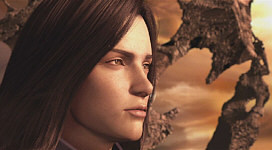 During the summer of 2001, two major releases tried to break the videogame jinx. From Super Mario Bros. through Double Dragon and Street Fighter, many have tried to adapt videogame material to the big screen, but none have truly succeeded. Nonetheless, this didn’t deter new attempts, which resulted in the two summer 2001 flicks.
During the summer of 2001, two major releases tried to break the videogame jinx. From Super Mario Bros. through Double Dragon and Street Fighter, many have tried to adapt videogame material to the big screen, but none have truly succeeded. Nonetheless, this didn’t deter new attempts, which resulted in the two summer 2001 flicks.
One of these created the biggest videogame hit to date. Lara Croft: Tomb Raider scored $131 million, which was a fairly respectable total. As of October 22, the film stood at tenth in the overall box office charts for the year. Unquestionably, it’ll drop out of the top 10 before all is said and done, but the movie remains a reasonable success.
However, our busty archeologist’s videogame competition fared much worse. Final Fantasy: The Spirits Within took its inspiration from the long-running FF role-playing game series that started on the Nintendo Entertainment System in 1990 but gained greatest success as a Playstation release later in the progression. With the tenth installment available in Japan and due in the US soon, the games continue to sell well.
Unfortunately, that popularity didn’t cross over to movie sales. With an enormous budget of $137 million, the computer-animated extravaganza that is Final Fantasy: The Spirits Within failed to make any impact at theaters. It limped off of screens after a paltry $32 million take that currently places it at 48th on the list of the year’s top-grossing movies. Expect it to drop much lower before the tallies end.
How did this happen? Of all the big, multi-jillion-dollar summer releases, Spirits tanked the worst. Ivan Reitman’s Ghostbusters rehash Evolution came pretty close, as it only snagged $38 million, but that still kept it a few spots above Spirits.
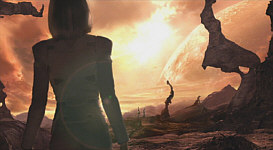 Spirits marked the second year in a row that studios attempted to interest teen boys - the prime summer movie demographic - in animated sci-fi/action experiences, but neither succeeded. 2000’s Titan AE used more traditional cel techniques, but it flopped even worse and it actually killed Fox’s feature animation department. Spirits had a similar impact, as Square - the company behind the videogames - has apparently indicated they won’t pursue future animation work.
Spirits marked the second year in a row that studios attempted to interest teen boys - the prime summer movie demographic - in animated sci-fi/action experiences, but neither succeeded. 2000’s Titan AE used more traditional cel techniques, but it flopped even worse and it actually killed Fox’s feature animation department. Spirits had a similar impact, as Square - the company behind the videogames - has apparently indicated they won’t pursue future animation work.
Did Spirits deserve such a terrible fate? Yes and no. The movie is actually a decent piece of work at times, as it occasionally creates a reasonably entertaining experience, and the animation can provide a stunning visual experience, but the overall result is somewhat bland and unmemorable.
Spirits follows Dr. Aki Ross (voiced by Ming-Na) as she tries to find a way to eliminate the “phantom” infestation of Earth. These creatures landed there years earlier and have killed millions. Working from “the Gaia Theory”, Aki tries to find the eight spirits that will unify things and cure the world of the phantoms. This is dangerous work, and the Deep Eyes - a military task force - helps her with this. Included in the four-man team is her ex-boyfriend Gray (Alec Baldwin), and she also works with Dr. Sid (Donald Sutherland), an aged colleague who elaborates the Gaia Theory.
As if the phantoms weren’t enough of a challenge, Aki and the others have to function in opposition with General Hein (James Woods). The military man lost his family to the phantoms and wants to annihilate them with the Zeus weapon, a doomsday device that may harm the Earth even more. Because of this, Aki and company race against the clock to find the final spirits before Hein wins his argument.
Though the story doesn’t make it sound that way, Spirits largely exists as a duplicate of 1986’s Aliens. The film takes so many cues from that classic that it often feels like a remake. Granted, it they were going to steal, at least they did it from the best, but the ways Spirits echoed Aliens made it seem much less effective. The former includes lines that strongly rehash those from Aliens, some of the action scenes look like carbon copies, and the female Deep Eye named Jane (Peri Gilpin) totally duplicates Vasquez.
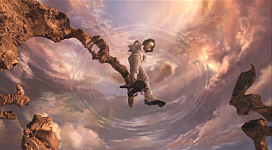 Essentially, Spirits takes the action tone of Aliens and melds it with an Eastern eco-sensibility. The whole Gaia aspect of the flick seems consistent with other Earth-oriented films like Princess Mononoke. This adds a little depth to the piece, but it feels somewhat forced; we’ve seen this kind of battle between the pro-ecology side and the violent, destructive baddies in the past, and Hein doesn’t do much to broaden the stereotype. Cripes, his outfit even came straight out of Nazi Germany!
Essentially, Spirits takes the action tone of Aliens and melds it with an Eastern eco-sensibility. The whole Gaia aspect of the flick seems consistent with other Earth-oriented films like Princess Mononoke. This adds a little depth to the piece, but it feels somewhat forced; we’ve seen this kind of battle between the pro-ecology side and the violent, destructive baddies in the past, and Hein doesn’t do much to broaden the stereotype. Cripes, his outfit even came straight out of Nazi Germany!
Spirits suffers from some muddled storytelling. The plot makes sense but a number of aspects seem vague and undeveloped. As I checked out the DVD’s audio commentaries, it was clear that even some of the film’s creators didn’t understand a lot of the tale. This didn’t harm the movie tremendously, but it left it with a weaker focus.
On the positive side, the action sequences seem quite well executed and exciting. Sure, they’re rehashed Cameronisms, but they still appear fun and compelling. These parts of the film create the most entertaining moments and are its highlights. I also liked the bittersweet tone that appeared at times; it gave the piece a surprisingly somber tone on occasion.
As for the animation, Spirits offers the first feature-length attempt to use photo-realistic humans. It doesn’t succeed, at least not consistently. At times the illusion can be quite convincing, as the characters appear almost indistinguishable from real people. However, these almost always occur in longer shots. When we get closer the impression collapses. Faces cause the most problems, as they almost never seem natural and believable. Mouth movements don’t match up tremendously well, and the whole thing has a rather artificial look to it.
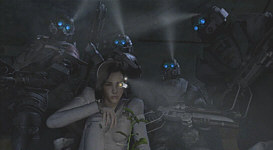 It’s this aspect of the production that causes some problems. If you attempt photo-realistic people, the illusion has to be virtually flawless or it becomes a distraction. With characters who aren’t supposed to appear perfect, we can forgive all sorts of concerns, for we accept them as part of animation. However, when you shoot for perfection, anything less detracts from the experience. In Spirits, this sense of “close but no cigar” makes it tougher to dive into the tale.
It’s this aspect of the production that causes some problems. If you attempt photo-realistic people, the illusion has to be virtually flawless or it becomes a distraction. With characters who aren’t supposed to appear perfect, we can forgive all sorts of concerns, for we accept them as part of animation. However, when you shoot for perfection, anything less detracts from the experience. In Spirits, this sense of “close but no cigar” makes it tougher to dive into the tale.
Actually, the animation seemed pretty showy at times, especially in regard to Aki’s hair. The animators tried so hard to add life to the film that they went too far. Aki’s tresses fly about with ridiculous abandon; they have a life of their own. Sure, some movement is important, but they took this to an artificial height.
Frankly, I’m not sure I see the point of photo-realistic animation. Sure, it makes sense in films like The Phantom Menace; whether one loves or hates Jar-Jar, he does integrate fairly naturally into the film, and his presentation as a believable being works. In that example, they created a creature who had to look real but not human. However, if you want cartoons to look like actual people, why not use true humans? They can interact with other computer-generated elements; the whole purpose of photo-realistic people largely escapes me other than as a demonstration of technology.
Ultimately, that’s what Final Fantasy: The Spirits Within seemed to be. The film had some good moments, and it must be respected as a groundbreaking piece of technical wizardry. However, the story fell flat much of the time, and the characters failed to capture my interest. Spirits was a moderately entertaining program, but other than its unusual animation, it did little to stand out from the pack.
The DVD:
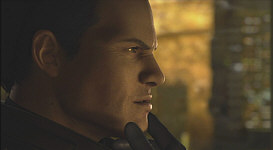 Final Fantasy: The Spirits Within appears in an aspect ratio of approximately 1.85:1 on this single-sided, dual-layered DVD; the image has been enhanced for 16X9 televisions. Transferred straight from the original computer files, this version of Spirits never saw a frame of film, and the pristine nature showed during this terrific presentation.
Final Fantasy: The Spirits Within appears in an aspect ratio of approximately 1.85:1 on this single-sided, dual-layered DVD; the image has been enhanced for 16X9 televisions. Transferred straight from the original computer files, this version of Spirits never saw a frame of film, and the pristine nature showed during this terrific presentation.
Sharpness looked immaculate. At all times, the movie showed excellent clarity and accuracy, as I detected no signs of softness or fuzziness during the flick. Moiré effects and jagged edges caused no concerns, and I witnessed no signs of edge enhancement. Since no print existed, we saw no source defects; it was a totally clean and fresh presentation.
Spirits didn’t feature a tremendously varied palette, as it tended toward a darker look. However, the colors provided came across as very tight and distinct. Oranges dominated the piece, mainly due to the phantoms, but other cooler hues appeared clear and accurate. All of the tones seemed to be rendered well. Black levels looked deep and dense, and shadow detail usually was appropriately clean but not excessively opaque. However, I did think some shots appeared somewhat dim. At times, the film actually looked like one that used “day for night” photography. Obviously it didn’t, but some scenes had that same sort of appearance as they showed an unnatural look to the lighting. Nonetheless, those were minor concerns, and overall, Final Fantasy provided a stunning visual experience.
Also excellent was the Dolby Digital 5.1 soundtrack of Final Fantasy. Overall, the soundfield offered a nicely involving and active experience. The forward soundstage provided a great deal of activity from the sides, most of which blended together well. Elements moved cleanly from channel to channel, and the localization seemed good. Music displayed fine stereo separation in the front, and the rears reinforced the score neatly.
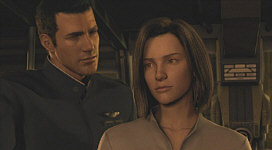 Speaking of which, the surrounds added a strong level of activity to the mix. The movie featured a lot of fine action sequences that creates a lively and vibrant atmosphere much of the time. All five speakers contributed accurate and useful information that made the track work well. My only complaint stemmed from a certain sense of sterility to the package. At times the soundtrack seemed a little too neat and clean, and it didn’t feel like a truly natural piece on occasion. This was a minor concern, but it kept the mix from achieving greatness.
Speaking of which, the surrounds added a strong level of activity to the mix. The movie featured a lot of fine action sequences that creates a lively and vibrant atmosphere much of the time. All five speakers contributed accurate and useful information that made the track work well. My only complaint stemmed from a certain sense of sterility to the package. At times the soundtrack seemed a little too neat and clean, and it didn’t feel like a truly natural piece on occasion. This was a minor concern, but it kept the mix from achieving greatness.
Audio quality appeared excellent. Dialogue sounded natural and crisp, with no concerns related to edginess or intelligibility. Music seemed really strong, as the score was quite bright and dynamic. The music appeared clear and vivid, and it showed nice low-end response as well. Effects also demonstrated excellent fidelity, with clean, accurate tones that displayed terrific depth. The bass came across as very tight and powerful without any boominess. Ultimately, Final Fantasy featured a fine auditory experience that seemed consistently satisfying.
Columbia-Tristar have issued Final Fantasy as a packed 2-DVD special edition. Many of the extras appear on the second disc, but DVD One tosses in a slew of materials as well, starting with three separate audio commentaries. Actually, the first is more of a text track, at least for those of us who don’t speak Japanese. This commentary features co-director Moto Sakakibara, sequence supervisor Hiroyuki Hayashida, sets and props lead artist Tatsuro Maruyama, and phantom supervisor Takoo Noguchi. All four men were recorded together for this running, screen-specific track. They speak Japanese, but subtitles - available in English and French - translate their remarks.
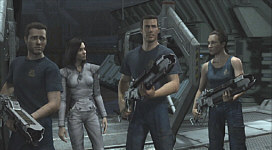 Overall, I thought this was a decent commentary. At times their statements tended toward the obvious, with remarks like “Aki is in danger here” and “the sky is orange”, and they provided a fair amount of self-congratulatory material as well. However, they also offered a reasonable amount of information about the production as they covered challenges encountered during the production as well as changes made through the many drafts and even a little criticism of some aspects of the flick. As a whole, it was a moderately interesting but unspectacular track.
Overall, I thought this was a decent commentary. At times their statements tended toward the obvious, with remarks like “Aki is in danger here” and “the sky is orange”, and they provided a fair amount of self-congratulatory material as well. However, they also offered a reasonable amount of information about the production as they covered challenges encountered during the production as well as changes made through the many drafts and even a little criticism of some aspects of the flick. As a whole, it was a moderately interesting but unspectacular track.
The second commentary provides English speakers as we hear from editor Chris S. Capp, animation director Andy Jones, and staging director Tani Kunitake. All three were recorded together for this running, screen-specific track. This piece seemed fairly dry and flat, as the technical elements dominated it. Some discussion of production concerns and alterations made along the way occurred, but for the most part, the participants talked about nuts and bolts animation areas. They also offered a lot of praise for the work, as we often heard how this was “amazing” and that was “fantastic”. This commentary wasn’t a bad listen, especially via Capp’s piece; he included some of the best information about the storytelling process. However, I think it’ll be most interesting for serious fans of the film.
Lastly, we find a third track on which we get the film’s isolated score along with commentary from composer Elliott Goldenthal. Score fans will likely be a little disappointed by the presentation. Offered in Dolby Surround 2.0, Goldenthal’s remarks periodically cover the music. Annoyingly, lots of empty spaces occur; Goldenthal’s statements go on top of the score but then we hear nothing - no music or speech - for long stretches. Most of the score appears untainted, but the alterations could be problematic.
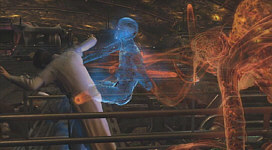 As for Goldenthal’s comments, he provides only scattered tidbits, but they’re fairly interesting. He mostly discusses why he used particular instruments and what he wanted to do with the music. Again, a lot of the track progresses without material, but when he speaks, Goldenthal offers some useful material.
As for Goldenthal’s comments, he provides only scattered tidbits, but they’re fairly interesting. He mostly discusses why he used particular instruments and what he wanted to do with the music. Again, a lot of the track progresses without material, but when he speaks, Goldenthal offers some useful material.
Boards and Blasts provides something that almost amounts to a separate version of the film. It shows Spirits through storyboards, rough computer animation, and some finished - or at least nearly done - shots as well. With a length of 81 minutes and 40 seconds, “B&B” doesn’t cover the whole movie, but it comes reasonably close as it offers quite a lot of material, and it’s a very nice presentation for those who like to observe the various stages of animation.
“B&B” includes some additional elements as well. There’s an “Optional Filmmaker Commentary” that features unspecified participants. I recognized Chris Capp and a couple of others, but I wasn’t sure about all of them. This is a fairly sparse affair, as remarks appear only sporadically. They generally echo the kinds of information found in the main film’s tracks, with a technical emphasis, but the piece still merits a listen; it works well for this sort of feature.
In addition, a Subtitled Factoid program that adds some tidbits about the movie. It contains notes about the animation techniques, some “history” of the film’s period and details about its gadgets, and some mistakes that appear along the way. It even ventures into sly “Pop-Up Videos” territory on occasion; for example, when Aki nods off, we see a definition of narcolepsy. As with the commentary, these snippets appear fitfully, but they’re a good way to watch “B&B”; they’d intrude on the main film, but they complement this boards and rough animation presentation.
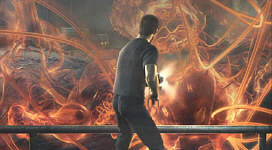 DVD One includes a slew of trailers. We find both a teaser and a standard theatrical trailer for Spirits itself as well as a “sneak preview” of the Playstation 2 Final Fantasy X game. In addition, ads for Men In Black, Starship Troopers, and Metropolis - the anime version, not the Fritz Lang classic - appear on the disc.
DVD One includes a slew of trailers. We find both a teaser and a standard theatrical trailer for Spirits itself as well as a “sneak preview” of the Playstation 2 Final Fantasy X game. In addition, ads for Men In Black, Starship Troopers, and Metropolis - the anime version, not the Fritz Lang classic - appear on the disc.
Now we move on to DVD Two. The centerpiece of this disc was The Making of Final Fantasy, an “interactive documentary” about the film. This program ran for 30 minutes and 40 seconds and combined lots of interviews with shots of production materials and a few movie clips. I didn’t care for the style used, as the show featured lots of jittery camera work and quick cuts that seemed odd for this kind of program. Also, a lot of the participants weren’t identified, which made the show less coherent.
Despite those issues, the documentary generally appeared reasonably interesting. Not surprisingly, it mainly focused on technical aspects of the production, as it went over the techniques used and demonstrated the work. I think that was why the program used the jumpy MTV-style look; the material tended to be so dry that someone must have felt they needed to spice up the footage. Overall, the show was a good overview of the production and the computer animation requirements. It didn’t go into great depth, but it still came across as a fairly effective discussion of the subject.
In addition, some extra material can be observed while you watch the documentary. 17 times during the show, an icon indicates you can press “enter” on your remote and access different video pieces. Each of these runs between 19 seconds and 10 minutes, 20 seconds, though most are under two minutes; all told, we find 37 minutes and eight seconds of footage.
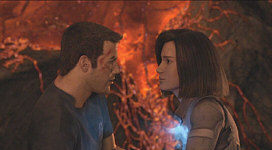 The bonus clips cover a lot of different subjects. Essentially it amounts to a second documentary, especially since it lasts longer than the main program itself, though the discussions generally elaborate on topics seen in the central show. These add some nice details about the production and merit a look.
The bonus clips cover a lot of different subjects. Essentially it amounts to a second documentary, especially since it lasts longer than the main program itself, though the discussions generally elaborate on topics seen in the central show. These add some nice details about the production and merit a look.
Seven of the 17 snippets also provide optional filmmaker commentary. These bits flesh out the material to a moderate degree. I don’t think any of them are terribly fascinating, but they give us some useful bits at times.
Note that the documentary’s chapters send you straight to each added bit. This feature is especially useful because I didn’t like watching them during the documentary itself. They became a distraction; when I left the show for a few minutes, it broke up the flow of that program and made it harder to take in the intent. As such, it was better to watch the extras one after another and not deal with them during the main show itself.
Outside of the documentary, additional supplements appear. Vehicle Scale Comparisons look at three different items: the Bandit, the Black Boa, and the Quatro. Each gets its own short video program that tells us about them and gives us details as we watch drawings, test footage, and other material. The clips run between 51 seconds and 69 seconds for a total of three minutes worth of footage. These add a little depth to the package but not a lot.
Character Files provides additional details about the movie’s main participants. We hear about Aki, Gray, Hein, Dr. Sid, Neil, Jane and Ryan. Each of the video pieces lasts between 78 seconds and two minutes, 54 seconds for a total of 15 minutes of material. These offer brief biographies of the characters as well as a few notes about the performers and animators involved. The snippets are generally pretty good, and they help flesh out the roles nicely.
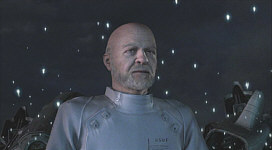 A feature that lets you re-edit the conference room scene, the Final Fantasy Shuffler offers 12 scene snippets to rearrange. However, this wasn’t as interesting as it sounds. Unlike similar features on DVDs like Die Hard, this one doesn’t provide alternate takes or vantage points. Instead, it’s the scene as shown in the film; it’s just been chopped into 12 bits. That means that you can change the sequence, but the result will make absolutely no sense. If you edit it in any way other than the normal sequential order, the piece is choppy and silly. These kinds of editors can be fun, but this one was pointless.
A feature that lets you re-edit the conference room scene, the Final Fantasy Shuffler offers 12 scene snippets to rearrange. However, this wasn’t as interesting as it sounds. Unlike similar features on DVDs like Die Hard, this one doesn’t provide alternate takes or vantage points. Instead, it’s the scene as shown in the film; it’s just been chopped into 12 bits. That means that you can change the sequence, but the result will make absolutely no sense. If you edit it in any way other than the normal sequential order, the piece is choppy and silly. These kinds of editors can be fun, but this one was pointless.
Also fairly useless was the Trailer Explorations area. This four-minute and 42-second piece basically just rehashed the teaser and the theatrical trailers seen on DVD One along with a few seconds of remarks from a filmmaker whose name I couldn’t understand - it sounded like Jim Haida, but I’m not sure. Anyway, he adds roughly 20 seconds worth of statements; otherwise, it’s all film clips. I thought we’d learn some insight into the trailer creation process, but that didn’t occur.
The Gray Project provides a five minute and 28 second “proof of concept” piece. Essentially it showed rough character animation that was intended to demonstrate the possibilities of the computer form. It’s a fun look at the early stages of project development, but it suffered from a lack of narration; some comments from filmmakers would have made it more useful.
The same problem plagued Compositing Builds. This seven minute and 38 second program offered a visual demonstration of the layers required for the compositing, and it was fairly interesting to see the scenes grow. However, narration would have made the piece more comprehendible and productive.
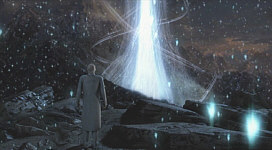 More Boards/Blasts picked up where the feature on DVD One left off, as we found an additional two minutes of those elements. With such a short running time, I don’t know why these bits didn’t appear on the first disc; they seemed oddly superfluous here.
More Boards/Blasts picked up where the feature on DVD One left off, as we found an additional two minutes of those elements. With such a short running time, I don’t know why these bits didn’t appear on the first disc; they seemed oddly superfluous here.
Matte Art Explorations took a six minute and five second look at some CGI art created for the film. We heard from an unnamed matte artist as he discussed his work and we watched examples of it. I enjoyed this feature, especially because I didn’t even know matte paintings had extended to the digital realm. It was an informative little feature, even though the anonymous artist did sound eerily like Peter Lorre.
In the same vein as clips from A Bug’s Life and Toy Story 2, the “Joke Outtakes” provided a little rough animation that showed falsified goof-ups from the set. We got 104 seconds of this material, most of which was violent in nature. The snippets seemed moderately amusing, but the Disney flicks already did this subject to death, and they ain’t getting any funnier.
The Original Opening showed exactly what it indicated: an unused beginning to the film. The four-minute and 45-second piece would have started the movie in a more low-key manner, and what we saw was almost finished animation but not quite; it still displayed some rough edges. Of particular interest was the alternate Aki; she looked noticeably different here.
Aki’s Dream is referred to as a “mini-movie” on the DVD packaging. What the nine-minute and 29-second program offered was a compilation of all Aki’s dreams from the movie. It’s a decent concept but nothing special.
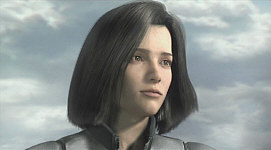 Within the DVD’s booklet we found some “Production Notes”. The provided a brief and superficial look at the production, but they weren’t a bad read.
Within the DVD’s booklet we found some “Production Notes”. The provided a brief and superficial look at the production, but they weren’t a bad read.
Final Fantasy packed in a mix of Easter eggs as well. Definitely the most prominent of these is a parody of the music video for Michael Jackson’s “Thriller”. On the second menu page from DVD Two, there’s a little box in the lower right corner of the screen. Click on that and bang - you’ve got 150 seconds of Aki and company boogieing to vintage MJ!
In addition, some DVD-ROM materials appeared. We got an “Interactive Film Exploration” which essentially showed the “Boards and Blasts” version of the movie along with the screenplay. The presentation was a little confusing, as it tried a bit too hard to reinvent the wheel, but it still provided a fairly interesting experience.
The “Virtual Tour of Square Pictures” offered a few different elements. We got some text descriptions of the various departments and we also could access some other segments. QuickTime programs showed trailers and “turn-around” views of some vehicles, and the area provided a wealth of stillframe materials. These covered all sorts of cool production art, from early character designs to sets and props. My only complaint about them? The images were tiny! They filled maybe a sixth of the screen, and their size couldn’t be increased. Otherwise, this domain included a lot of solid artwork.
In the “Web Gallery” we got links to a bunch of different sites. It featured connections to the official movie domain, Columbia-Tristar Entertainment, Sony, Sony Pictures Entertainment, and the “FF DVD Online Gateway”. Lastly, the “Aki Screen Saver” will plop the sexy cyber gal on your computer.
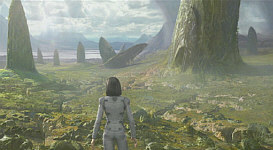 When I had to grade the extras of Final Fantasy, I ran into some problems. On one hand, the disc clearly included a wealth of materials. From the two audio commentaries to the isolated score/commentary to the “boards and blasts” version of the film to the documentary with scads of bonus footage, the set packed a ton of footage. Based on sheer numbers, one could easily argue the package merited an “A+”.
When I had to grade the extras of Final Fantasy, I ran into some problems. On one hand, the disc clearly included a wealth of materials. From the two audio commentaries to the isolated score/commentary to the “boards and blasts” version of the film to the documentary with scads of bonus footage, the set packed a ton of footage. Based on sheer numbers, one could easily argue the package merited an “A+”.
However, at times this felt like a case of quantity over quality. While most of the pieces were interesting, none of them stood out as particularly special. I thought the commentaries were pedestrian, the documentary seemed glib and without much depth, and I just didn’t get as good a feel for the production as I would have liked. The numbers were there, but my overall impression was of a very good but not stellar set of supplements. I thought Spirits would be on a par with great packages like Snow White and the Seven Dwarfs and The Phantom Menace, but it never quite made it to that level.
Still, Final Fantasy: The Spirits Within provided a very strong DVD experience, even if the movie itself was nothing special. Overall, the film seemed moderately entertaining, and it provided a periodically stunning technical milestone, but it featured a story that was little more than a generic rehash of other plots, and the animation did little to convince me that photo-realistic computer work is the wave of the future. The DVD presented excellent picture and sound plus a large package of extras that weren’t uniformly great, but they added a lot to the set. Ultimately, Final Fantasy was a fine DVD that at least merits a rental just due to the many strengths of the discs.